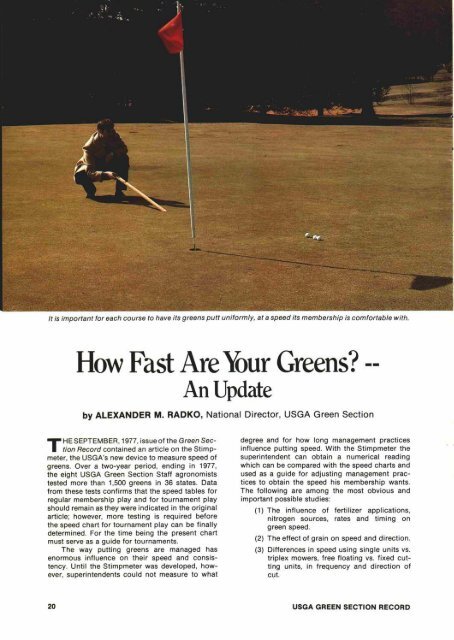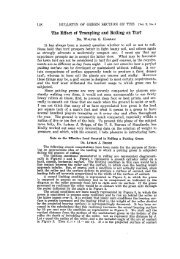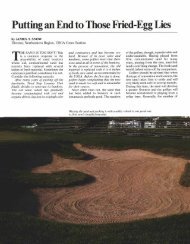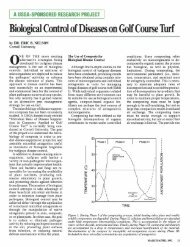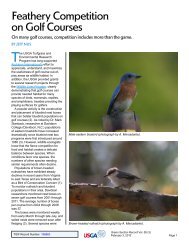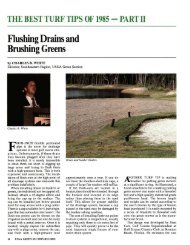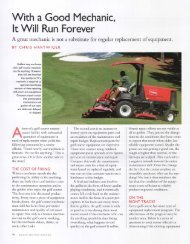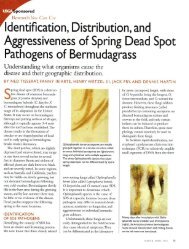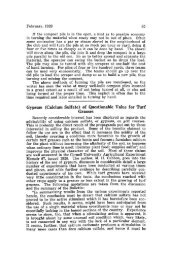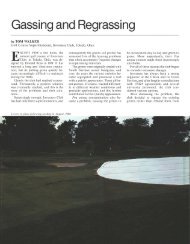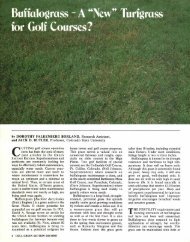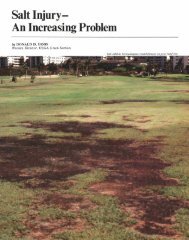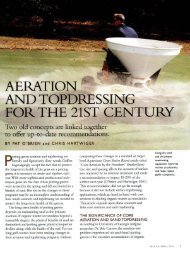How Fast Are Your Greens? - USGA Green Section Record
How Fast Are Your Greens? - USGA Green Section Record
How Fast Are Your Greens? - USGA Green Section Record
- No tags were found...
You also want an ePaper? Increase the reach of your titles
YUMPU automatically turns print PDFs into web optimized ePapers that Google loves.
It is important for each course to have its greens putt uniformly, at a speed its membership is comfortable with.<strong>How</strong> <strong>Fast</strong> <strong>Are</strong> <strong>Your</strong> <strong><strong>Green</strong>s</strong>?An Updateby ALEXANDER M. RADKO, National Director, <strong>USGA</strong> <strong>Green</strong> <strong>Section</strong>--THE SEPTEMBER, 1977, issue of the <strong>Green</strong> <strong>Section</strong><strong>Record</strong> contained an article on the Stimpmeter,the <strong>USGA</strong>'s new device to measure speed ofgreens. Over a two-year period, ending in 1977,the eight <strong>USGA</strong> <strong>Green</strong> <strong>Section</strong> 8taff agronomiststested more than 1,500 greens in 36 states. Datafrom these tests confirms that the speed tables forregular membership play and for tournament playshould remain as they were indicated in the originalarticle; however, more testing is required beforethe speed chart for tournament play can be finallydetermined. For the time being the present chartmust serve as a guide for tournaments.The way putting greens are managed hasenormous influence on their speed and consistency.Until the 8timpmeter was developed, however,superintendents could not measure to whatdegree and for how long management practicesinfluence putting speed. With the 8timpmeter thesuperintendent can obtain a numerical readingwhich can be compared with the speed charts andused as a guide for adjusting management practicesto obtain the speed his membership wants.The following are among the most obvious andimportant possible studies:(1) The influence of fertilizer applications,nitrogen sources, rates and timing ongreen speed.(2) The effect of grain on speed and direction.(3) Differences in speed using single units vs.triplex mowers, free floating vs. fixed cuttingunits, in frequency and direction ofcut.20<strong>USGA</strong> GREEN SECTION RECORD
(4) The effect of double vs. single cutting.(5) The effects of aeration, spiking, verticalmowing - before and after.(6) The effects of dew and surface moisture,wet vs. dry greens.(7) Differences between grass cultivars prominentlyused for putting greens - stolonizedvs. seeded greens, bentgrasses vs.bermudagrasses, etc.(8) The effect of weeds such as Poa annua,clover, crabgrass, chickweed, etc., onspeed. Speed differences when Poa annuais in seed vs. when not in seed.Preliminary tests also indicate some interestingbut not-so-obvious variables:(1) There is a definite change in the speed ofgreens when measured in the morning;after cutting, and in the afternoon on themore liberally fertilized greens. <strong><strong>Green</strong>s</strong>fed sparingly show less change.(2) The bench-setting of a mower does not insurethat the greens are being cut at thatheight. The thickness of the bedknifegreatly influences putting green cuttingheights. Free floating units require a settingdifferent from rigid mowing units.(3) The frequency of cut has a decided effecton green speed. Dou!;>le-cutting on successivedays increases the speed of greens.(4) Heavy topdressing of greens with a soilmixture slows the green until the materialis worked well into the turf. Heavy, infrequenttopdressings cause speeds to oscillatewhereas light, frequent topdressingsimprove speed and consistency.Used properly the Stimpmeter will be an invaluableasset to putting green management programs.Its strength is its simplicity! A speed readingtakes just a few minutes. It is possible, therefore,to monitor the speed of greens on a frequentschedule, measure differences and devise ways topromote uniformity through a greater part, or allof the playing season.Stimpmeters and an operating manual areavailable to every golf club wanting one, as follows:(1) One will be mailed in care of the golfcourse superintendent to each club subscribingto the <strong>USGA</strong>'s Turf Advisory Servicein 1978 as part of the annual fee.(2)*<strong>USGA</strong> Member and non-Member Clubsand Courses will be entitled to purchaseone Stimpmeter at a cost of $15. It too willbe mailed in care of the superintendent.(3)*Members of the Regional AssociationLiaison Committee may purchase oneStimpmeter at $15.*Order your Stimpmeter directly from the United StatesGolf Association, Golf House, Far Hills, N.J. 07931.Studies are needed to determine how various management programs affect speed of greens.MARCH/APRIL 1978 21


